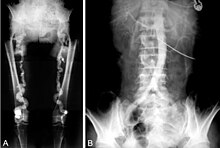Monckeberg's arteriosclerosis
| Mönckeberg's sclerosis | |
|---|---|
| Other names | Medial calcific sclerosis or Mönckeberg medial sclerosis |
 | |
| Microphotography of arterial wall with calcified (violet colour) atherosclerotic plaque (haematoxylin & eosin stain) | |
| Specialty | Cardiology |

Mönckeberg's arteriosclerosis, or Mönckeberg's sclerosis, is a form of arteriosclerosis or vessel hardening, where calcium deposits are found in the muscular middle layer of the walls of
Signs and symptoms
Typically, Mönckeberg's arteriosclerosis is not associated with symptoms unless complicated by
Cause
Minor degrees of calcification of the cardiovascular system are common in elderly people,[8] and the prevalence of vascular calcification is increased by some diseases (see Epidemiology section). Vascular calcification results from the deposition of calcium phosphate crystals (
It is unclear whether Mönckeberg's arteriosclerosis is a distinct entity or forms part of a spectrum of vascular calcification that includes atherosclerosis and calcification in the inner layer of the artery wall (
Diagnosis
Often Mönckeberg's arteriosclerosis is discovered as an incidental finding in an
Management
This section is empty. You can help by adding to it. (October 2019) |
Epidemiology
The prevalence of Mönckeberg's arteriosclerosis increases with age and is more frequent in diabetes mellitus, chronic kidney disease,
References
- ^ "Mönckeberg arteriosclerosis" at Dorland's Medical Dictionary
- ^ PMID 18536656.
- Who Named It?
- ^ J. G. Mönckeberg. Über die reine Mediaverkalkung der Extremitätenarterien und ihr Verhalten zur Arteriosklerose. Virchows Archiv für pathologische Anatomie und Physiologie, und für klinische Medicin, Berlin, 1903, 171: 141-167.
- ^ ISBN 978-0-471-25185-9.
- PMID 12761260.
- PMID 15820199.
- ^ PMID 18815240.
- ^ PMID 18667741.
- PMID 21196233.
- PMID 16343348.
- PMID 2946818.
- PMID 3783282.
- PMID 1950137.
- ^ PMID 8353913.
- PMID 9484982.
- ^ PMID 16685578.
